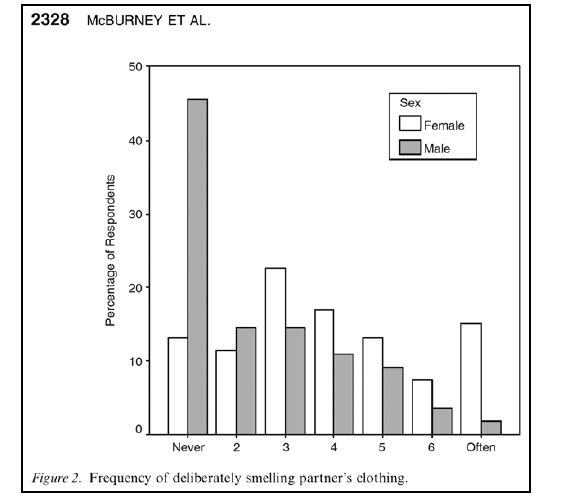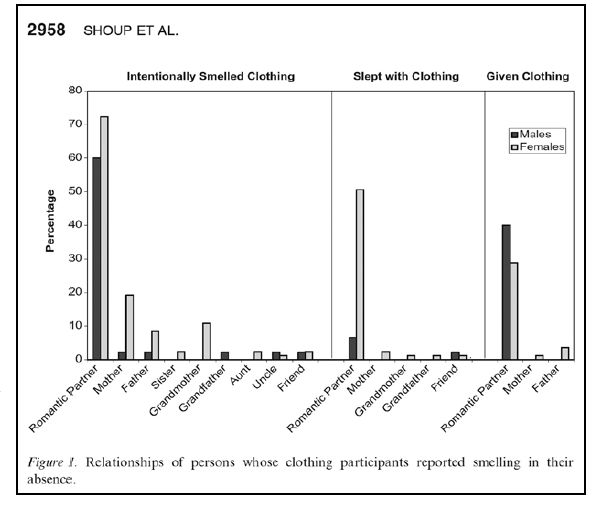
Research about kin and romantic partner scents
compiled by Alice Shirell Kaswell
Partner’s Body Odor vs. Relatives’ Body Odor
“Partner’s
Body Odor vs. Relatives’ Body Odor: A Comparison of Female
Associations,” Agnieszka Sorokowska, Marina Butovskaya, and Elizaveta
Veselovskaya,
Polish Psychological Bulletin, vol. 46, no. 2,
pp. 209–213. The authors, at the University of Wroclaw, Poland, and
Russian State University for the Humanities, Moscow, explain:
Here
we analyzed the relationship between perceived similarity of body odor
to the judges’ relatives and their partners, and characteristics
attributed to the odor donor. Seventy-six women were asked to smell one
of the scents of twenty-nine men, and rate variables related to
potential sexual interest in odor donor.... We found that perceived
similarity to a partner’s scent was positively correlated with ratings
of variables related to potential sexual interest in the odor donor,
whereas the resemblance to a close relative’s scent did not correlate
with these assessments.
The Common Smell of Human Twins
“Body
Odor Similarity in Noncohabiting Twins,” S. Craig Roberts, L. Morris
Gosling, Tim D. Spector, Paul Miller, Dustin J. Penn, and Marion Petrie,
Chemical Senses, vol. 30, no. 8, 2005, pp. 651-656. The authors, at the University of Liverpool, report:
Here
we show that odors of identical twins (but not dizygotic twins) can be
matched by human sniffers at rates better than chance, even when the
twins are living apart. In addition, matching frequencies for identical
twin odors were not significantly different from those for duplicate
odors from the same individual. These results indicate an important
genetic influence on body odor and the potential for developing
technologies for human odor printing.
 Smelling Sweetie’s Clothing (2006)
Smelling Sweetie’s Clothing (2006)
“Olfactory
Comfort: Smelling a Partner’s Clothing During Periods of Separation,”
Donald H. McBurney, Melanie L. Shoup, and Sybil A. Streeter, Journal of Applied Social Psychology, vol. 36, no. 9, 2006, pp. 2325-2335. The authors, at the University of Pittsburgh, explain:
We
demonstrate for the first time that most women, and some men,
deliberately smell their partners’ clothing when they are apart. We
asked undergraduate men and women who were, or who had ever been, in a
committed heterosexual relationship if they had ever slept with an
article of a partner’s clothing or deliberately smelled a partner’s
clothing during periods of separation. Both men and women reported that
smelling an absent partner’s clothing made them feel happy, comfortable,
and secure. We suggest that olfactory comfort is a significant
component of attachment and is likely to involve family members other
than partners.

Detail from the study “Olfactory Comfort: Smelling a Partner’s Clothing During Periods of Separation.”
Smelling Sweetie’s Clothing (2008)
“Olfactory Comfort and Attachment Within Relationships,” Melanie L. Shoup, Sybil A. Streeter, and Donald H. McBurney,
Journal of Applied Social Psychology, vol. 38, no. 12, 2008, pp. 2954-2963. The authors report:
We replicated a previous study that found
that men and women often smell their sexual partners’ clothing when they
are apart (McBurney, Shoup, & Streeter, 2006). We found that women
tend to perform this behavior across a broader range of relationships
than do men. We asked 128 participants if they had ever intentionally
smelled another person’s clothing, slept with another person’s clothing
because of its smell, or given another person an article of their own
clothing. The most common response was a romantic partner’s clothing.
However, women more often than men reported smelling the clothing of
family members.
Detail from the study “Olfactory Comfort and Attachment Within Relationships.”





No comments:
Post a Comment